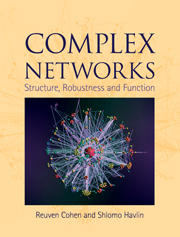Book contents
- Frontmatter
- Contents
- 1 Introduction
- PART I RANDOM NETWORK MODELS
- 2 The Erdős–Rényi models
- 3 Observations in real-world networks: the Internet, epidemics, proteins and DNA
- 4 Models for complex networks
- 5 Growing network models: the Barabási–Albert model and its variants
- PART II STRUCTURE AND ROBUSTNESS OF COMPLEX NETWORKS
- PART III NETWORK FUNCTION: DYNAMICS AND APPLICATIONS
- Appendix A Probability theoretical methods
- Appendix B Asymptotics and orders of magnitude
- Appendix C Algorithms for network simulation and investigation
- References
- Index
2 - The Erdős–Rényi models
from PART I - RANDOM NETWORK MODELS
Published online by Cambridge University Press: 05 August 2013
- Frontmatter
- Contents
- 1 Introduction
- PART I RANDOM NETWORK MODELS
- 2 The Erdős–Rényi models
- 3 Observations in real-world networks: the Internet, epidemics, proteins and DNA
- 4 Models for complex networks
- 5 Growing network models: the Barabási–Albert model and its variants
- PART II STRUCTURE AND ROBUSTNESS OF COMPLEX NETWORKS
- PART III NETWORK FUNCTION: DYNAMICS AND APPLICATIONS
- Appendix A Probability theoretical methods
- Appendix B Asymptotics and orders of magnitude
- Appendix C Algorithms for network simulation and investigation
- References
- Index
Summary
Before 1960, graph theory mainly dealt with the properties of specific individual graphs. In the 1960s, Paul Erdős and Alfred Rényi initiated a systematic study of random graphs [ER59, ER60, ER61]. Some results regarding random graphs were reported even earlier by Rapoport [Rap57]. Random graph theory is, in fact, not the study of individual graphs, but the study of a statistical ensemble of graphs (or, as mathematicians prefer to call it, a probability space of graphs). The ensemble is a class consisting of many different graphs, where each graph has a probability attached to it. A property studied is said to exist with probability P if the total probability of a graph in the ensemble possessing that property is P (or the total fraction of graphs in the ensemble that has this property is P). This approach allows the use of probability theory in conjunction with discrete mathematics for studying graph ensembles. A property is said to exist for a class of graphs if the fraction of graphs in the ensemble which does not have this property is of zero measure. This is usually termed as a property of almost every (a.e.) graph. Sometimes the terms “almost surely” or “with high probability” are also used (with the former usually taken to mean that the residual probability vanishes exponentially with the system size).
- Type
- Chapter
- Information
- Complex NetworksStructure, Robustness and Function, pp. 9 - 15Publisher: Cambridge University PressPrint publication year: 2010

